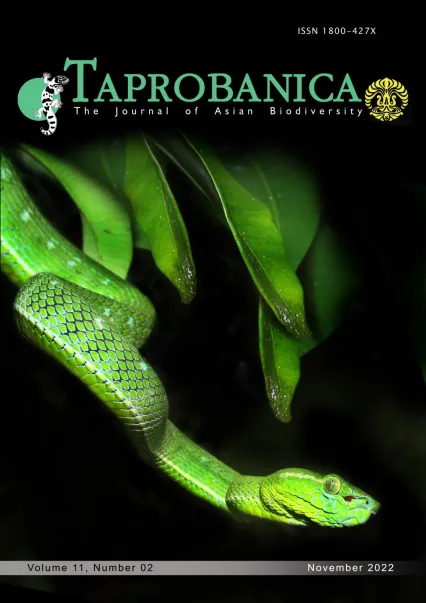

v11i2.291
Volume 11 | Number 2 | November 2022
Short Note
ISSN: 1800-427X (printed)
eISSN: 1800-427X (online)
DOI:10.47605/tapro.v11i2.291
Submitted date: 9 May 2022
Accepted date: 30 October 2022
Published date: 22 November 2022
Pp. 111–113.
Scent rubbing in carnivore species at Gavier Lake, Gujarat, India
K. Trivedi*, C. Patel & A. Desai
*Corresponding author. E-mail: krunal.trivedi.7567@gmail.com
Scents are one of the most common means of animal communication. Some animals use scent communication for many purposes including determining age and sex, marking their territories, and finding mates. Scent rubbing is a poorly understood way of marking in which animals rub their bodies against a variety of surfaces, many of which have intense odours. Individuals collapse their forelegs then push forward with their hind legs, rubbing their face, neck, and back onto the destination of the scent in the most well-known occurrences among carnivores. Most commonly, they put their own scent on the object while infusing the object’s scents onto their bodies. Faeces of other animals, meat, intestinal contents and insecticide are among the substances that elicit scent-rubbing. As a result, the subject's pelages are infused with the odour of these substances. Odours produced by sweat glands, urine, faeces and vaginal secretions often induce this behaviour, which is prominent in carnivore species. They scent rub as an olfactory communication method, releasing chemical odours to increase the chances of being recognised by conspecifics. Canids and other carnivores are well known for rubbing themselves on various scents, while smaller carnivores have been shown to increase caution and alter their feeding behaviour when exposed to the scent of larger carnivores .
Section Editor: Lee Harding
eISSN: 1800-427X (online)
DOI:10.47605/tapro.v11i2.291
Submitted date: 9 May 2022
Accepted date: 30 October 2022
Published date: 22 November 2022
Pp. 111–113.
Scent rubbing in carnivore species at Gavier Lake, Gujarat, India
K. Trivedi*, C. Patel & A. Desai
*Corresponding author. E-mail: krunal.trivedi.7567@gmail.com
Scents are one of the most common means of animal communication. Some animals use scent communication for many purposes including determining age and sex, marking their territories, and finding mates. Scent rubbing is a poorly understood way of marking in which animals rub their bodies against a variety of surfaces, many of which have intense odours. Individuals collapse their forelegs then push forward with their hind legs, rubbing their face, neck, and back onto the destination of the scent in the most well-known occurrences among carnivores. Most commonly, they put their own scent on the object while infusing the object’s scents onto their bodies. Faeces of other animals, meat, intestinal contents and insecticide are among the substances that elicit scent-rubbing. As a result, the subject's pelages are infused with the odour of these substances. Odours produced by sweat glands, urine, faeces and vaginal secretions often induce this behaviour, which is prominent in carnivore species. They scent rub as an olfactory communication method, releasing chemical odours to increase the chances of being recognised by conspecifics. Canids and other carnivores are well known for rubbing themselves on various scents, while smaller carnivores have been shown to increase caution and alter their feeding behaviour when exposed to the scent of larger carnivores .
Section Editor: Lee Harding
- List of Articles & Contents





